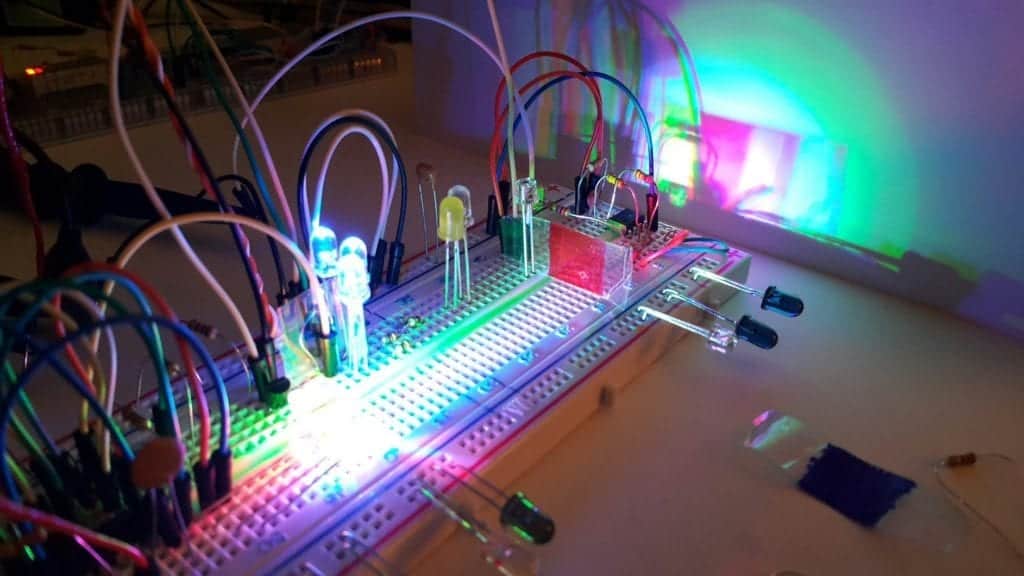Visible light communications (VLC) is an emerging field within the communications sector that focuses on providing a medium in which data can be transmitted using a part of the electromagnetic spectrum that is visible to the human eye.
Numerous work in optical communications has already been created. However, all of them focus on the transmission of light using fiber and free-space, which already pose large issues in infrastructure development.
With the use of the visible spectrum and light-emitting diodes (LEDs), VLC forgoes the usual problems with data connectivity and is able to provide even higher rates for the transmission of data.
VLC Technology Basics:
Visible light communications (VLC) is a method of communication that uses light for the transmission of data. As opposed to other forms of communication that use light, VLC uses the visible light spectrum, which is in the 430 to 770 THz frequency range and is modulated in order to transmit data.
VLC technology takes advantage of LED lighting and puts it to use as a transmitter. It is now seen as a potential replacement for Radio Frequency (RF) technology and generally has the upper hand as it is able to transmit data at ultra-high speeds and at high bandwidths.
Important Characteristics:
Below are several characteristics of VLC that provide insight as to why it is seen as a good alternative over existing communication technologies.
Spectrum Availability: VLC is more than capable of filling the gap between user demand and network capacity due to its broad spectrum of use, which provides a wide range of available frequencies for use. It uses the visible light region of the electromagnetic spectrum (430 to 770 THz frequency range), which is over 1,000 times broader than the existing RF technology, which in turn operates at 3 Hz to 300 GHz frequencies.
Safety: As VLC makes use of LED lighting for the transmission of data, it is seen as a safer medium for communication, as opposed to RF. It carries no hazard to human health and safety and does not interfere with various pieces of critical equipment.
Efficiency: VLC technology is capable of providing high outputs while using minimal energy due to its use of efficient light sources as a medium of transfer.
Security: The signals emitted by VLC are closely-confined within an area as visible light is unable to pass through opaque objects. Any data transmitted within a VLC system is secure as light signals are easily managed and controlled.
Licensing: RF technology often suffers from licensing issues due to its use over a broad area. Various frequencies are subject to availability as well as regulations. In contrast, light used by VLC is free as it only makes use of relatively unsophisticated equipment to operate and visible light, which is free.
Data Rates: High volumes of data can be transferred over a VLC system at generally low costs.
Architecture:
A VLC system generally consists of two integral parts: the transmitter and the receiver. The transmitter (LED bulb) is responsible for the transmission of data by emitting and modulating visible light. These light signals are received by a receiver that is attached to a device. It is primarily responsible for receiving light signals and interpreting these signals into readable data.
Both parts can be subdivided into three common layers, which are the physical layer, MAC layer, and the application layer.
MAC Layer:
According to IEEE 802 LAN/MAN standards, the medium access control (MAC) layer is mainly responsible for the transmission of data packets within a wireless network. For VLC system, however, this layer is responsible for a variety of other tasks, which include:
- Providing support in terms of mobility, dimming, visibility, security, color function, and visible-light personal area network (VPAN) association and disassociation
- Providing schemes for mitigation of flickering
- Generation of network beacons for coordinating devices
- Providing a reliable link between peer MAC entities
Physical Layer:
The physical layer provides the physical specification of the device and provides the relationship between the device and the medium. It deals with the connectivity of both the signaling mechanism and the actual hardware. It also defines the physical aspects of the receiver and transmitter in terms of hardware equipment, cabling, wiring, frequencies, and the physical manifestation of the binary signals.
Application Layer:
The application layer lies at the core of the transmitter and receiver. It defines the actual commands, responses, data types, and status reporting that is supported by the protocol. It contains the actual application that is responsible for interacting with the user. It is responsible for the conversion of user requests into demands on the system as well as convert signals received from the transmitter into actual readable data by the user.
Modulation Techniques:
Within a VLC system, the transmitter is responsible for the transmission of data signals in the form of modulated light. There are various modulation techniques used in data transmission, which could also have an effect on the speed in which the data is transmitted.
On-Off Keying (OOK): As the name suggests, OOK modulation entails two voltage levels, which are delivered by turning the LED on and off – 1 is represented by the light turned on and 0 represented by the light turned off. This method is able to provide a constant stream of data but is not optimal as it wastes energy due to control being based on the width of the pulse.
Pulse Width Modulation (PWM): Information is delivered according to the duration of pulses of light. Each pulse is able to convey more than one bit of data but may entail longer pulses than OOK. Data can also be transmitted in an analog format, which is relatively simple to implement.
Pulse Position Modulation (PPM): Data is encoded using the position of the pulse within a frame. Duration of the frame will have to be longer in order to transmit more than one bit of information at a given time. It is able to deliver variations in data while using the same amount of optical energy within a given frame.
Variable Pulse Position Modulation (VPPM): VPPM is quite similar to PPM, with the addition of allowing the pulse width to be controlled for light dimming support. VPPM is quite essential in VLC as it simultaneously allows illumination, dimming control, and communication. Within each pulse, it can carry vast amounts of data, but is generally more complex, and is also more susceptible to outside noise.
Color-Shift Keying (CSK): Illumination systems that make use of RGB-type LEDs can benefit from CSK. The data transmitted using CSK modulation depends on the variations in the colors of light as opposed to variable intensities, which means light intensity can be maintained.
Orthogonal Frequency Division Multiplex (OFDM): OFDM has been widely used for digital signals for TV, radio, and even WiFi, but can also be modified for use in optical systems. It uses a set of sub-carriers, each at different, but harmonically-related, frequencies.
Spatial Modulation (SM): Several techniques exist that could allow the determination of the source of an optical signal. Spatial determination allows the use of multiple sources of information at a given time to convey multiple streams of independent data, or to strengthen the transmission of data using similar signals. These multiples could be in the form of multiple LEDs within a single fixture.
Demand Factors for VLC Technology:
There exists a wide potential for the applications of VLC technology with the still increasing adoption of mobile electronic devices, as evidenced by the vast growth in mobile ownership over the past five years.
Contrary to the name, however, a great majority of all mobile traffic, 70% to be exact, occurs indoors and at fixed locations. This creates a big opportunity to offload traffic to localized access in smaller cells through the placement of fixed access points in areas with heavy mobile traffic.
By combining overhead illumination with data communication, VLC is able to offer an optimal method of data transmission capable of transferring high amounts of data within a short amount of time while providing light to indoor spaces where humans exist.
The Future of VLC:
Current research into 5G connectivity, the next generation of mobile network architecture capable of delivering higher speeds with lower latency, suggest that cell sizes are becoming smaller, which will be around 50 m. This poses severe challenges on existing technologies as smaller cells in greater quantities need to be deployed in more locations to bring signals closer to users. Various problems posed by smaller cells include:
- Location – more cells require more land
- Backhaul – newer cells will need to connect with the rest of the network
- Power – smaller cells will require their own power supply including backup
- Spectrum – different cells will need to use certain frequencies within the spectrum
VLC is being considered as a viable alternative to the current prevailing RF technology. It has the potential to augment cellular communications by providing a means to decrease the cell sizes without incurring much cost in terms of infrastructure and energy consumption by riding on existing lighting infrastructure. Because of the benefits of visible light communications and LiFi, companies around the world are working hard on developing LiFi products and LiFi solutions.
And as the world pushes even further into greener technologies, the use of more efficient methods of lighting such as LED to transfer data without using more energy, is certainly a welcome development.








